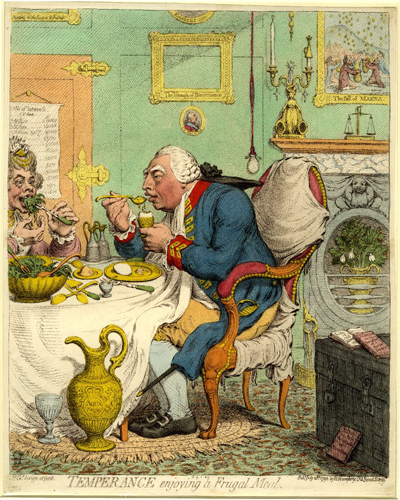Temperance Enjoying a Frugal Meal
This print is the second of a paired set of prints. The first was A Voluptuary under the Horrors of Digestion published earlier the same month. Like the earlier and less finished Frying Sprats [1791] and Toasting Muffins [1791], Temperance... satirizes the notorious miserliness of George III and Queen Charlotte, a miserliness suggested and reinforced by nearly every detail of the print.

© Trustees of the British Museum
To begin with there is the royal meal consisting of nothing more exotic or expensive than soft-boiled eggs and salad greens. And the beverage of choice is not a fine wine, but Aqua Regis, i.e. water.
The royal chair and bell pull are protected against wear by plain and crude coverings. The royal rug is similarly protected by a simple mat. And the royal person himself is protected against spills by the table cloth which conveniently and inexpensively doubles as a napkin. All of this to protect the royal breeches which have been clearly patched to extend their loyal service.
The furnishings around the room tell a similar tale. The grate behind the King contains winter flowers but no sign of a warm fire so that even the ornamental figure above the grate apppears to have his hands in a muff. The candelabra on the mantle suggests that only one candle at a time is used to provide light in the royal chamber. And the figure of Munificence that is part of the candelabra design has only empty cornucopias to offer.
The books in the room include an Essay on the Dearness of Provisions, Dr. Cheyne on the Benefits of a Spare Diet, and the Life of Old Elwes, a famous miser.
Conspicuously empty picture frames suggest what is lacking in the lives of the royal pair. Missing works include (not surprisingly) Epicurus, the Philosopher of pleasure, but more damning The Parting of the Loaves and Fishes where Christ feeds the multitudes, and one of Gillray's own "serious" works, The Triumph of Benevolence[1788] which would have shown John Howard, the reformer, relieving the distress of a soldier and his family in debtor's prison. A portrait of George III as John Kyrle, Pope's famous"Man of Ross" appended to the empty frame of the Triumph of Benevolence would seem to suggest that any comparison of George with either John Howard or John Kyrle would be an empty gesture.
But perhaps most damning of all is the double bolted door of the strong room behind the Queen with its table of interest suggesting, no doubt unfairly, that their frugality is part of a puposeful and miserly accumulation of wealth.
Sources and Reading
- Commentary from the British Museum on Temperance Enjoying a Frugal Meal
- Draper Hill, Mr. Gillray The Caricaturist, 1965
- Draper Hill, Fashionable Contrasts, 1966, #57
- "George III of the United Kingdom," Wikipedia
- "Charlotte of Mecklenburg-Strelitz," Wikipedia
- Thomas Wright and R.H. Evans, Historical and Descriptive Account of the Caricatures of James Gillray #86
Comments & Corrections
NOTE: Comments and/or corrections are always appreciated. To make that easier, I have included a form below that you can use. I promise never to share any of the info provided without your express permission.